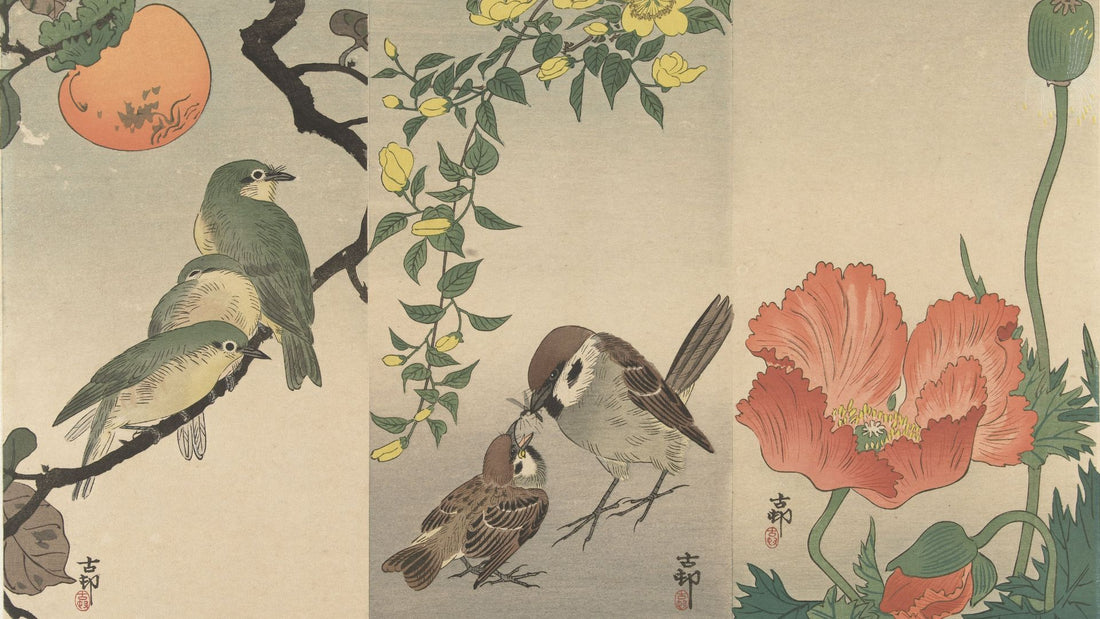
The fascinating Woodblock Prints of Ohara Koson
Share
An introduction to the Life and Art of Ohara -Koson (1877-1945)
Ohara Koson was one of the most influential Japanese woodblock print artists of the early 20th century. Known for his innovative designs and nature scenes, Koson helped popularize the art of shin-hanga ("New Prints" -The new wave in ukiyo-e) and ukiyo-e woodblock printing in general.
Ohara Koson prints featuring birds, flowers, and landscapes are still beloved by collectors today. The Museum of Fine Arts (MFA) in Boston boasts one of the world's most important collections of Japanese prints, including many exceptional examples by Ohara Koson.
Born in 1877 near Tokyo, Ohara Koson originally studied under the famous artist Kiyochika Kobayashi.
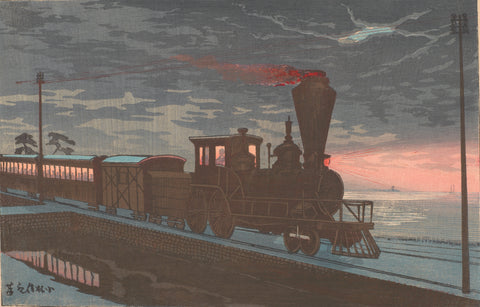
View of Takanawa Ushimachi under a Shrouded Moon, 1879 - Kiyochika Kobayashi
Ohara Koson excelled at capturing the vibrancy and detail of of the animal world gaining recognition for his talent while still a teenager.
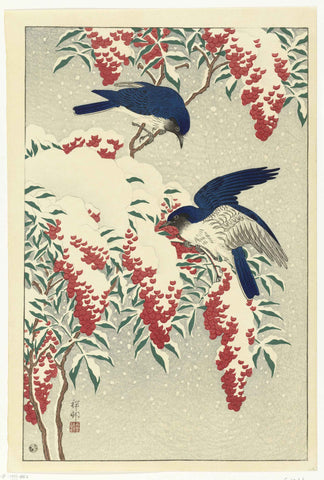 By his early 20s, Koson was creating prints for publications like the prestigious Kokka art journal. His fame continued to grow rapidly.In the early 1900s, Koson collaborated with the publisher Watanabe Shozaburo to create some of his most iconic prints.
By his early 20s, Koson was creating prints for publications like the prestigious Kokka art journal. His fame continued to grow rapidly.In the early 1900s, Koson collaborated with the publisher Watanabe Shozaburo to create some of his most iconic prints.Watanabe was a pivotal figure in the shin-hanga movement, which aimed to revitalize the art of woodblock printing using modern techniques. Under Watanabe's guidance, Koson created vibrant prints that integrated traditional ukiyo-e methods with a more contemporary, stylized look.
Flycatchers on a nandina bush, Ohara Koson
Ohara Koson's Subjects: Capturing Nature's Beauty (kachō-e)
In the manner of a naturalist illustrator, he documents the bird species visible in Japan at the time, in their natural environment. Some of his most famous works feature majestic birds like herons and peacocks, their feathers capturing a sense of movement and life. The plants and flowers in Ohara Koson artworks are equally vivid, subtly blended colors bringing Hydrangeas, Lelies, Poppies, Lotus flowers and Irises to life on the page. Flower and bird prints belong to a specific category of ukiyo-e called kachō-e

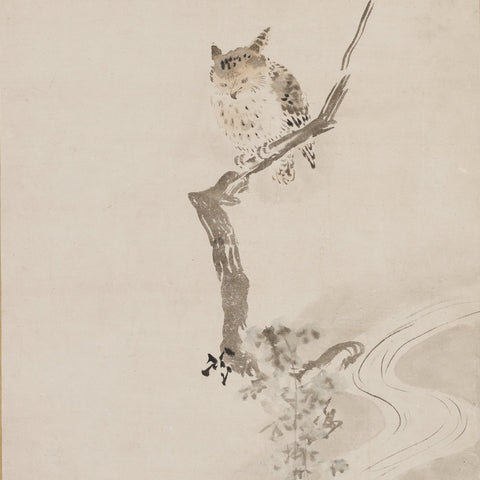 According to curator Kendall H. Brown, Koson saw himself as a modern successor to the great Edo-period artist Itcho Hanabusa, who was renowned for his bird and flower paintings. Koson likely took the “o” in his art name from Hanabusa’s “o” to signal this connection. While Koson's designs still draw on traditional ukiyo-e subjects, his woodblocks have a cleaner, more graphic look compared to earlier prints.
According to curator Kendall H. Brown, Koson saw himself as a modern successor to the great Edo-period artist Itcho Hanabusa, who was renowned for his bird and flower paintings. Koson likely took the “o” in his art name from Hanabusa’s “o” to signal this connection. While Koson's designs still draw on traditional ukiyo-e subjects, his woodblocks have a cleaner, more graphic look compared to earlier prints.Koson also created a number of prints featuring delicate landscapes. From serene rural scenes to views of temples, shrines, and forests, his landscape prints blend subtle colors into evocative environments. Whether focusing on swaying flowers or a flock of egrets at rest, Koson's prints capture ephemeral moments of grace and natural splendor.
The Shin-Hanga Printing Process
Ohara Koson’s close partnership with publisher Watanabe Shozaburo was crucial to his success and artistic development. Together, they perfected a complex, multi-step printing process that allowed Koson to create graduated color tones and realistic textures in his prints.
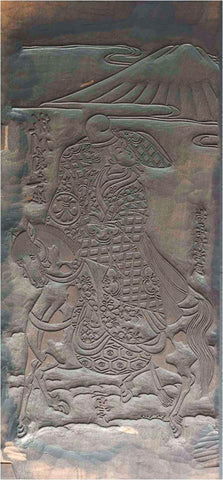 First, Koson would paint a detailed drawing on paper, which craftsmen would then recreate as printing blocks. A key block printed the outlines while additional blocks were carved to apply colors. Using 10 or more blocks per print, the craftsmen meticulously carved away wood or applied pigments by hand to create subtle variations in texture and hue.
First, Koson would paint a detailed drawing on paper, which craftsmen would then recreate as printing blocks. A key block printed the outlines while additional blocks were carved to apply colors. Using 10 or more blocks per print, the craftsmen meticulously carved away wood or applied pigments by hand to create subtle variations in texture and hue.With shin-hanga techniques, Koson could create modern, sophisticated designs that reproduced the visible brushstrokes of his original drawings. The partnership between publishers like Watanabe and gifted artists like Ohara Koson allowed the art of ukiyo-e woodblock printing to evolve from Edo-period beginnings into a new genre.
Ukiyo-e, image of a floating, ephemeral world. It was under this name that Japanese prints first appeared in the late 17th century. The character uki, imbued with Buddhist connotations, evokes the sadness of the earthly world, that of appearances, as opposed to the sacred, unchanging world.
Global Recognition and Legacy
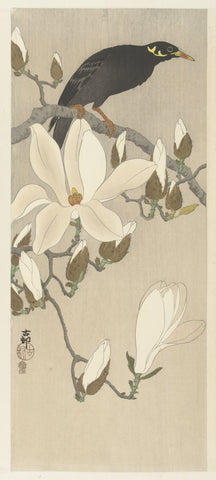 In addition to commercial success in Japan, Ohara Koson’s prints attracted attention overseas from early in his career. His work was exhibited in England's National Gallery as early as 1900, when Koson was just 23 years old. Over the next few decades, he received awards at international expositions in the U.S. and across Europe, cementing his reputation worldwide.
In addition to commercial success in Japan, Ohara Koson’s prints attracted attention overseas from early in his career. His work was exhibited in England's National Gallery as early as 1900, when Koson was just 23 years old. Over the next few decades, he received awards at international expositions in the U.S. and across Europe, cementing his reputation worldwide. Today, Koson's prints can be found in the collections of prestigious institutions like the Museum of Fine Arts, Boston, the Art Institute of Chicago, the Los Angeles County Museum of Art, and many more. His masterful depictions of nature continue to inspire artists and printmakers in Japan and beyond. Along with Shoson, Hasui, and other shin-hanga greats, Koson’s legacy lives on as a pioneer of modern woodblock printing.
Forgers and Authenticating Koson Prints
 The global acclaim for shin-hanga prints also had an unfortunate downside: artwork forgeries. Koson’s prints were widely forged in Japan starting in the 1930s, with fakes and reprints continuing to flood markets in subsequent decades. However, experts can identify authentic Koson prints based on details like the carving quality of print blocks and the characteristics of Koson’s signature or seals.
The global acclaim for shin-hanga prints also had an unfortunate downside: artwork forgeries. Koson’s prints were widely forged in Japan starting in the 1930s, with fakes and reprints continuing to flood markets in subsequent decades. However, experts can identify authentic Koson prints based on details like the carving quality of print blocks and the characteristics of Koson’s signature or seals.Ohara Koson used different seals and signatures throughout his career, and it is very difficult to date his works precisely. Prints made after the great Kanto earthquake of 1923 generally have brighter colors than his early works. Some were printed with different color variations.
Kendall Brown, curator of Asian Art at the Los Angeles County Museum of Art, advises collectors to look for seals reading “Koson” rather than just “o” or “Ohara.” Authentic Koson prints also have very fine carved lines, without the blurriness typical of reproductions. Specialists can analyze paper quality and pigments as well to verify real Koson artwork. Taking care to authenticate is key for appreciating Koson’s mastery and legacy as an artist. When you buy a reproduction from Wallango, you take no risks! Our reproductions are taken from digitized vintage prints and printed on fine art paper.
Kendall Brown is Professor of Asian Art History at California State University Long Beach. He holds a PhD. in Art History from Yale University and an MA. from UC Berkeley. He publishes in several areas of Japanese art, focusing on popular arts of the 1920s and 1930s, as well as on Japanese-style gardens in North America.
The Enduring Appeal of Shin-Hanga
During Ohara Koson's lifetime from the late 1800s to the mid 1900s, Japan went through a turbulent transformation from a feudal society to a modern nation-state. Amidst these changes, Koson and his fellow shin-hanga artists reinvented traditional woodblock printing as a contemporary art form. More than a century later, Koson's prints and those of his contemporaries remain hugely popular among collectors and art enthusiasts around the world. Although Ohara Koson's period prints regularly exceed the thousand-dollar mark, he remains far below more highly-rated artists such as Hokusai, whose prints reach record heights, selling for several million dollars.
For some, the appeal lies in the serene landscapes, graceful birds and flowers that Koson captured so masterfully. For others, his prints represent a moment in the rich history of Japanese aesthetics and its evolution through different eras. Koson's ability to blend tradition with modern techniques also parallels the larger story of Japan's emergence as a modern nation state while retaining its distinct culture.
Above all, Ohara Koson's enduring popularity is a testament to his vision and skill as an artist. His striking prints impress viewers with their vivid colors, fine details, and sense of natural beauty and harmony. From falling leaves to a flock of herons in flight, Ohara Koson opened the eyes of a wide public to the precious miracles of the natural world that surrounds us (and which, alas, is tending more and more to disappear). His artistic legacy continues to fascinate and inspire new generations, and we are delighted to be able to share with you our love for the great master that was Ohara Koson.

1 comment
👏